Ever since we decided to undertake this trip, Helen had been itching to show me around her old stomping grounds in Hong Kong. Now if I’m honest, I really wasn’t quite sure what to expect when we landed. I think I had visions of a somewhat claustrophobic centre of high rise skyscrapers and apartments populated by a mass of people. Hong Kong Chinese, ex pats and mainland Chinese (not that I’d know the difference between them and the Hong Kong Chinese). I expected the harbour to be spectacular but further than that, I didn’t really know what to expect.
Our final approach to the runway on Lantau island’s North Coast was unfortunately shrouded in low cloud, so what would have been a spectacular first sight of the city and Islands turned out to be a glimpse of buildings and water, grey and indistinct, through breaks in the cloud.
As the Davies family had lived in HK for 8 and a half years, for once we knew exactly where we were going and how we were going to get there. The A22 bus would take us from the airport and stop only a few hundred meters from the United Services Recreation Club (USRC) where we were staying for the week. An octopus card gives access to the busses, trams, ferries and the MTR (Mass Transport Railway, the HK underground rail network), so once purchased we hopped on the next A22.
It’s a far cry from Vietnam and the other countries we’d been through over the previous 10 weeks or so since we touched down in Mumbai. The bus was new, clean and on time. The roads organised and disciplined and completely devoid of any form of livestock. It was actually quite a shock to the system, I’d grown accustomed to the (sometimes choreographed) chaos of India and other parts of SE Asia.
All the way into town, Helen was excited to point out the sights that we could see and to point out each of the islands and areas we were passing through. All linked with wide, efficient road systems, bridges and tunnels. As an aside, the largest bridge in the world now links Lantau Island with mainland China at Macao. Officially known as the Hong Kong-Zhuhai-Macao Bridge, it is a 55km bridge/tunnel system consisting of a series of three bridges, an undersea tunnel that dives under the sea for a distance to allow shipping to pass overhead and four artificial islands.
Forty minutes later we hopped off the A22 near the centre of town on Kowloon and completed our journey on foot. The USRC seemed to be an oasis of ‘Britishness’. A British style bar, typically traditional sports trophies and boards of club officials. Outside are tennis courts, a swimming pool, bowls green and other sports courts. All of which brought back memories of childhood (or teen hood at least) for Helen, reminiscing about summers spent by the pool and ice cream signed off against her Dad’s account.
And all ready for Christmas.
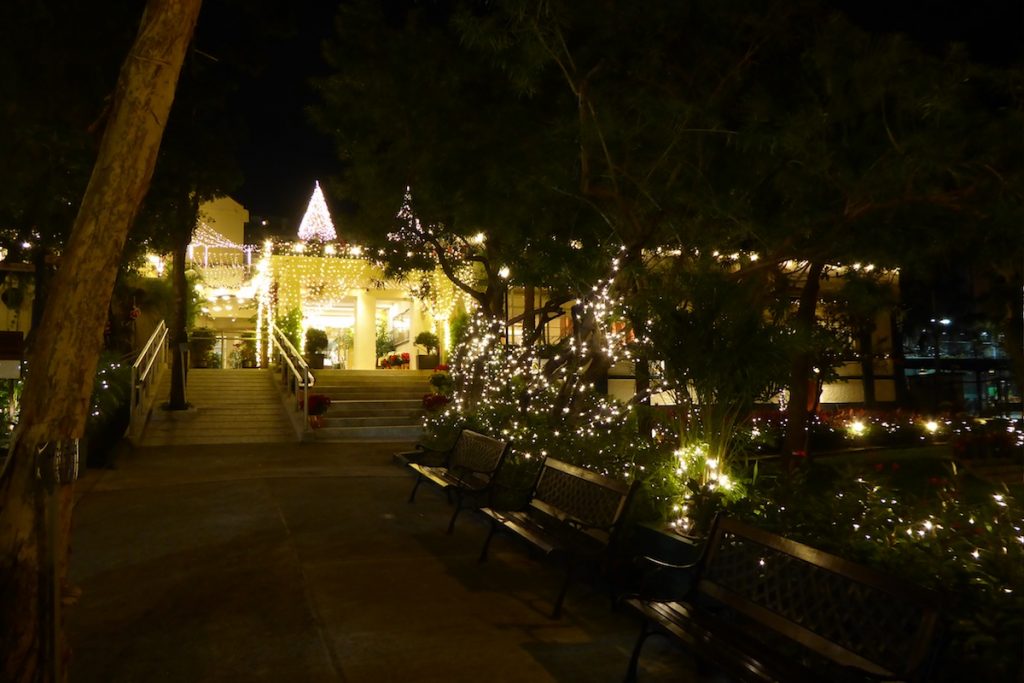
When I say an oasis of Britishness, that is assuming that my preconceptions of Hong Kong we’re in any way accurate.
Walking out later that evening, after a ‘snack’ of nachos so large it replaced dinner, we headed down toward the harbour and I started to get a first hand feel of what 21st century Hong Kong is about.
The Yue Hwa Chinese Products Emporium. Home to countless jars of Chinese herbal remedies, dried meats, clothes , jewelry and white rabbits. Not furry ones, white candy wrapped in rice paper. (Another memory, so we bought a bag and wandered out in silence with teeth stuck together with white goo.) Just down the street though is a Rolex store, then a Longines store, then a Bose store. Next a guy in a suit tries to get me to have a suit made, then I’m offered ‘fake watches’. Just before we come to the next Rolex store.
Then there are the shopping malls. They’re everywhere. And big. And in many cases very exclusive. You walk in to the vast lobbies (more like plazas) be surrounded by Chanel, Dior, Louis Vuitton, Hermés, Tiffany’s and many many more designer stores.
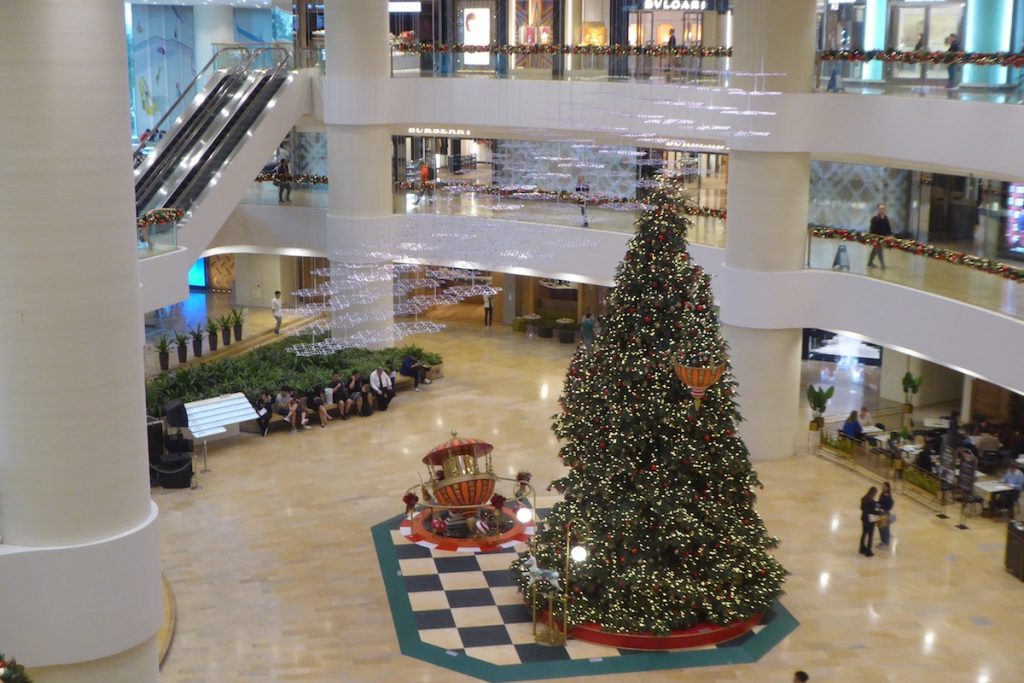
Sometimes as you walk around there’ll be a sense of déjà vu as you see another Chanel logo. But no, it’s in fact another store. In the same mall. Many of the malls, large and small, are in the Tsim Sha Tsui area (on Kowloon Island) or in the central area of Hong Kong Island a short hop across the harbour on the Star Ferry (more about that later). Absolute heaven for those wealthy shoppers. But even though we’re approaching Christmas, and there are Christmas decorations everywhere (including a real forty foot tree in one mall) the actual walkways and shops themselves are really quiet.
While I’m talking about wealth, I’ve never seen so many Tesla cars in one place. They seem as common as Mercedes are in the UK. Apparently this is due to a tax break that the Hong Kong government set up to encourage the purchase of electric cars, but all it did was to allow the rich boys to buy their toys a bit more cheaply, which they did with a vengeance.
Back to my visions of crowded streets.
Walking around the central business district (CBD) roads are quiet, and footpaths are even quieter. Where are the crowds I had been expecting? You have to look up. Above the roads are elevated walkways, covered and protected from both rain and sun, connecting office blocks, shopping malls, tramways and the MTR. People don’t walk on the streets in Hong Kong, they walk above them with a disdaining glance down at the thought of actually having to cross a road! But it does make for a safe environment (and a dry one as it did rain while we were in town).
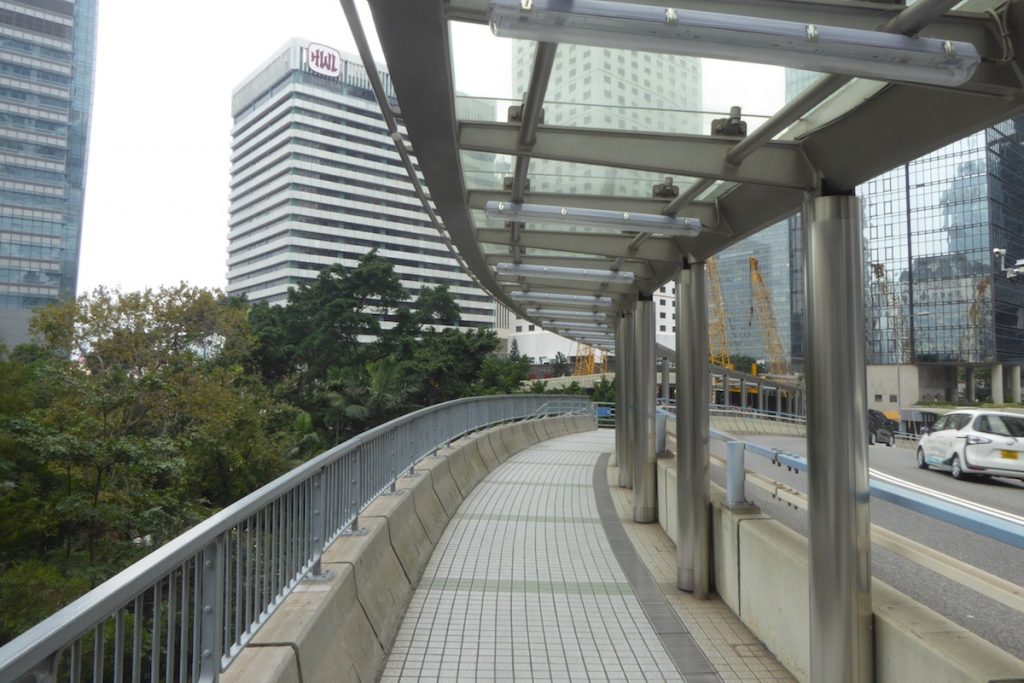
So the CBD is a civilised, westernised, melange of skyscrapers, malls, walkways and rich boy’s toys. What about the Chinese side of Hong Kong? Away from the main streets, down side roads and alleys, Chinese signs dominate. At night these are illuminated lighting the streets with vivid and sometimes garish hues. These streets have no walkways, and are filled with locals and tourists alike.
Then there are the markets.
Temple Street, with row upon row of stalls selling things as diverse as mobile phone covers and ‘I  HK’ T-shirts to street food and sex toys!
HK’ T-shirts to street food and sex toys!
Mong Kok, street after street of stalls and shops, selling clothes, goldfish, gadgets and computers. Nearby there’s also a bird market selling birds in tiny cages. Something I personally found quite distasteful leaving me with a keen desire to open the doors and liberate the occupants.
Shau Kei Wan Market, at the eastern side of Hong Kong Island at the end of the tram line. A real locals’ market selling fish, meat, fruit, vegetables and pretty much anything you might want to eat. The Chinese like their fish fresh, and these are so fresh that they’re still flapping about in bowls of shallow water trying to escape their inevitable fate. Prawns, crabs and lobster are all the same. Harsh voices call out in their local dialect, offering the seafood to local restauranteurs and daily shoppers alike.
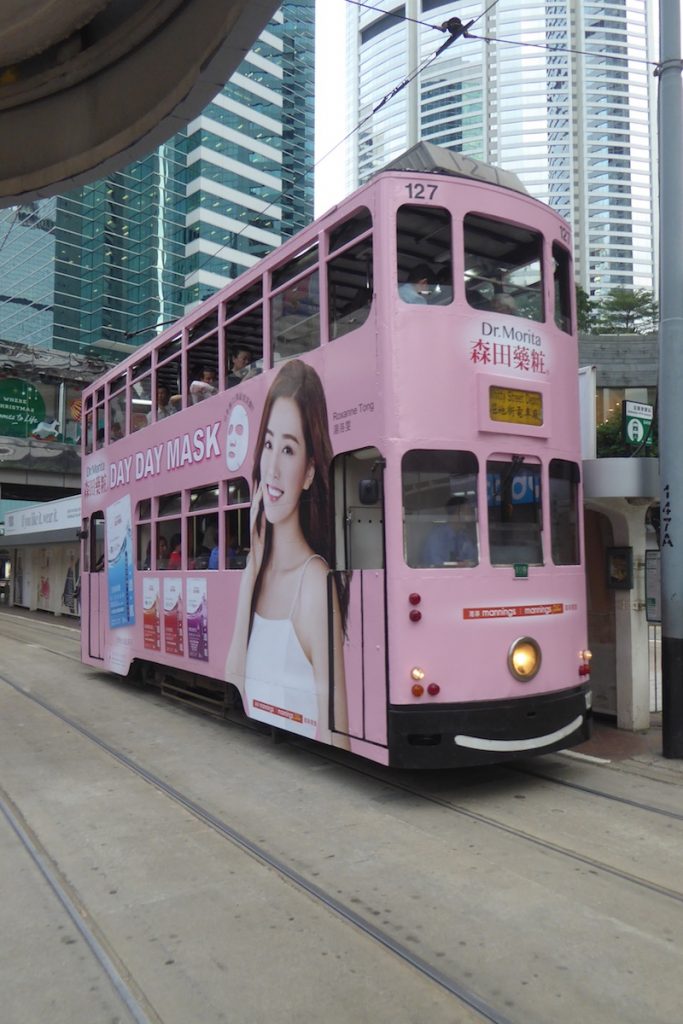
All these markets are very different, some targeted at tourists but others very much there for the population of over seven million. And they offer a completely different perspective on the city.
Overall, the main area of Hong Kong is this mix of exclusive malls, traditional markets, classic old trams and the Star Ferry, founded in 1880 and described as the best value cruise in the world by The Lonely Planet, ploughing its way across Victoria Harbour between Kowloon and Hong Kong Islands. It is spectacular, giving views all round of the high rise Hong Kong CBD, Kowloon and the more distant Lantau. The same view you would get from on board one of the many cruise ships that visit and dock in the port. You can also see up to the Peak, above the CBD, and to the green hills in the distance.
Whether it’s the best ferry journey or not, we’ll let you know after we’ve been on the ferry between Wellington and New Zealand’s South Island through the Marlborough Sound.
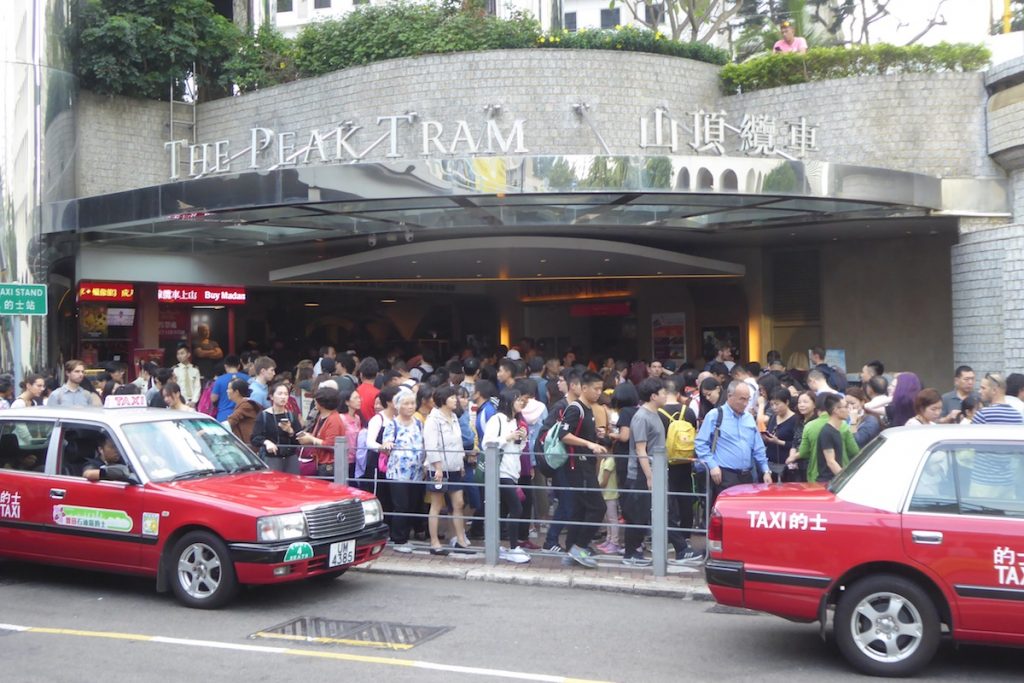
The Peak Tram, technically a funicular, whisks you from just above the CBD to just below Victoria Peak (at 553 meters, the highest point in Hong Kong). When you get to the top, you’re greeted by, yes, a shopping mall. Multi level, it’s actually quite a challenge to find your way out into the open, but when you do (and as long as it’s clear) you’re rewarded by superb views looking down over the island and harbour. Taking a walk around the peak you soon leave behind the tourists and the city and get a view of the other side of Hong Kong. The bit that I wasn’t really aware of. A panorama of blue sea, beaches, islands and green forests. It turns out that something like 70% of Hong Kong is actually national park.
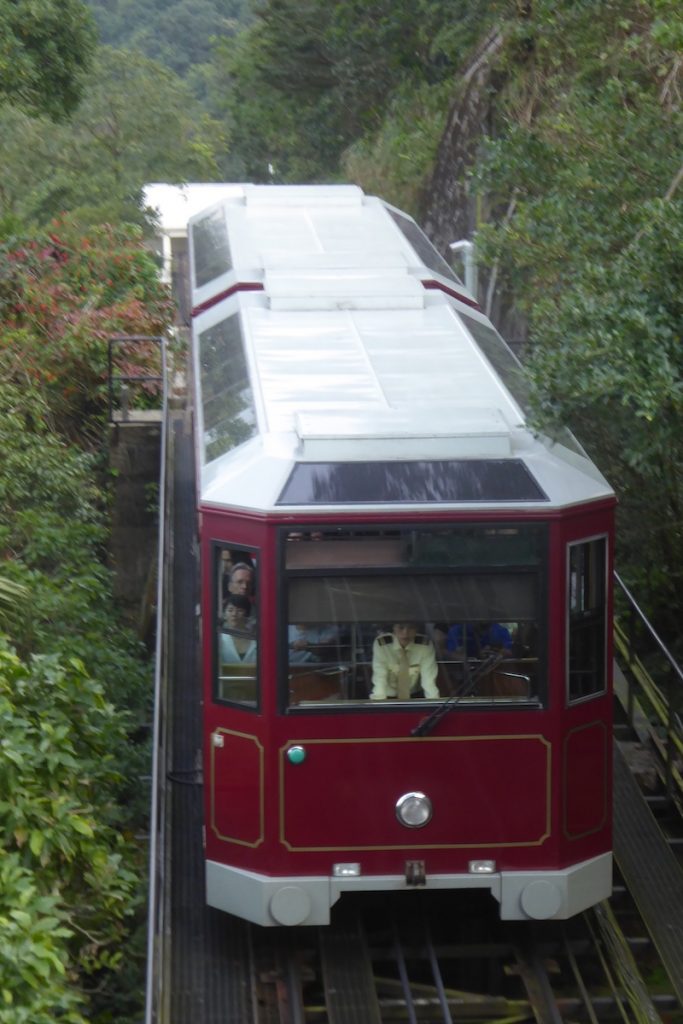
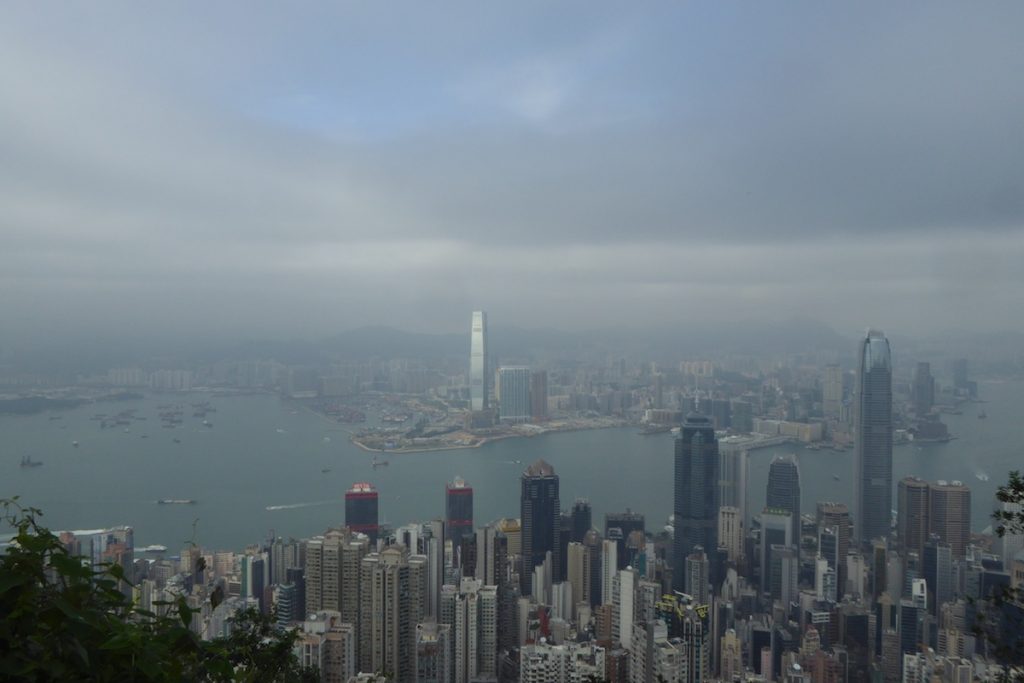
Water, and water transport form a mainstay of life in the territory. Ferries are a main commuter route, not only across the harbour, but between islands as well. Fast and efficient they whisk you out to the outlying suburbs quicker than you could commute into a decent sized town in the UK.
The Star Ferry has been taking passengers across Victoria Harbour since 1880 and the boats actually look as if they could have been made, if not in 1880, at least in the fifties. They have two decks, the upper deck from which you get the magnificent views of the harbour costs a whopping 2.5 HK$, the lower deck takes passengers and cargo. The views, even though the weather was not great for us, were still very good and we used the ferry several times to get across to Hong Kong Island. Even though it’s not the fastest way across, it certainly is the most iconic.
On the subject of the harbour, each evening there is a vibrant laser light show from the already brightly illuminated skyscrapers lighting up the sky. Viewed from our Kowloon vantage point allowed us to appreciate the extent of the light show both in front of us from Hong Kong Island and from the hotels behind us.
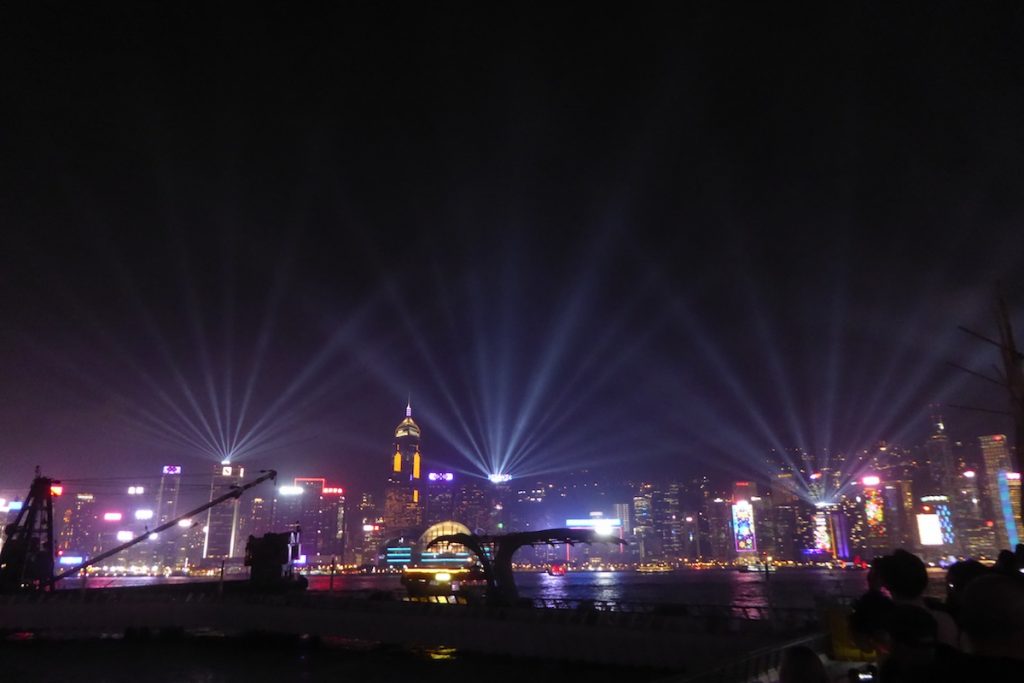
Aside from the Star Ferry, other ferries whisk you from the piers over to the other islands, and we caught a fast catamaran to take us over to Lantau island, the home of the Big Buddha.
We landed on Hong Kong’s largest island at Silvermine Bay. A beautiful stretch of deserted beach. Beaches were something that I’d not associated with Hong Kong, but they are not only plentiful, but are beautiful and peaceful in equal measure. They must provide a wonderful weekend and evening contrast to the city environment. So after a stroll around the bay we caught the bus, not to the north where Mickey Mouse and Disneyland have set up stall, but around the coast (again largely deserted) and up to the Po Lin monastery. The Big Buddha is big! Understandably there are a crowd of tourists, this is one of the must see sights, but it isn’t heaving like some places we’ve been. Maybe because it’s winter and although sunny, not particularly warm.
At the top of 268 steps and at an altitude of over 500 meters the statue, more correctly known as the Tian Tan Buddha, stands over 26 meters tall. It was unveiled in 1993 and can still claim to be the tallest seated bronze Buddha in the world. The views from the podium on which Buddha sits are far reaching. It’s not just the Buddha though. Back down the steps is the Po Lin monastery, replete with a vegetarian restaurant where you can get cheap food all day long. Behind that is the temple of 10,000 Buddhas. All around the walls are tiny carved Buddhas.
It’s all very new though, and quite touristy. The alternative way up to the complex, and down is via the Ngong Ping 360, a 25 minute cable car ride that takes you right back down past the airport to the harbour where the MTR awaits. To get to the cable car though, you are channeled along a street full of tourist and souvenir shops to part you from some more of your HK dollars.
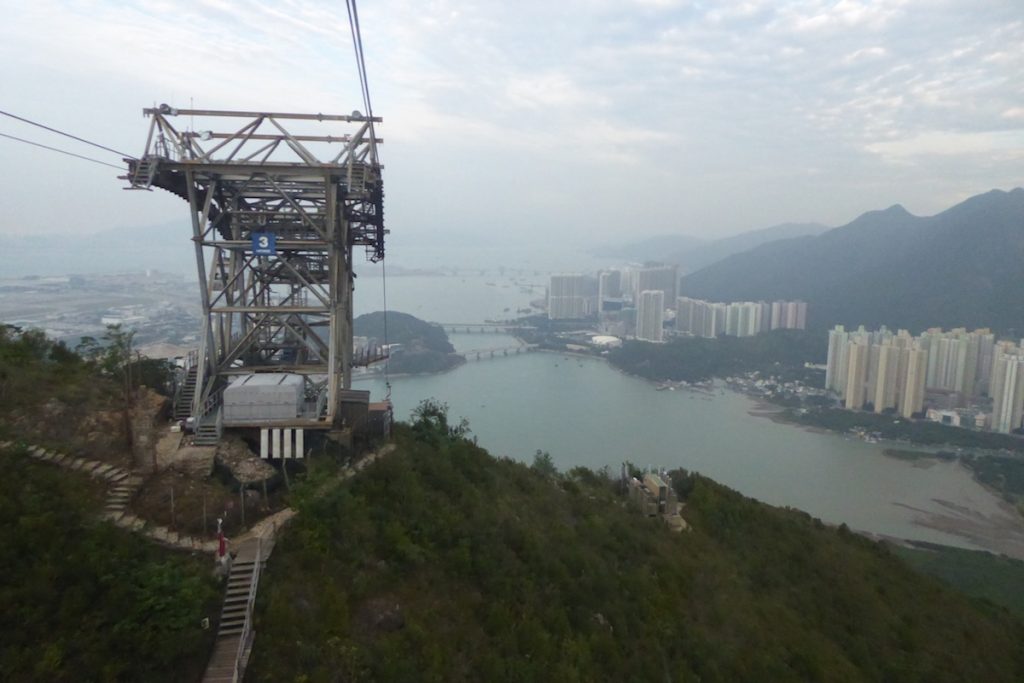
Some of Helen’s old friends and family friends were about whilst we were in town so that took us out to Stanley Bay, with it’s Finnish Christmas market for lunch and out on a small speedboat to a seafood restaurant in an outlying Bay for yet more delicious local food.
Before we left, Helen showed me her old haunts, where her family had lived, where she had gone to school, the old sports fields (that are still there) and of course the USRC.
I think I left Hong Kong with a very different view from my original expectations.
There seem to be two very different faces to it. One is the post colonial, high tech, wealthy corporate and very western face. Ex pats, foreigners, Chinese with apparently extensive wealth living a seemingly privileged lifestyle (by any standards) juxtaposed with the image I had of Hong Kong of crowded streets, markets with local food thrumming with local Hong Kongers. As well as that, it is not the one dimensional, high rise, metropolis I had envisioned. In fact it is a relatively small (but still crowded) high rise CBD surrounded by green hills, mountains, islands, beaches and warm seas. Much more than just a city but a diverse country with acres of green space, blue seas and beaches.
A little something for everyone.

2 thoughts on “Old Stomping Grounds 🇭🇰”
Only just found this- we enjoyed having lunch together at the Shanghaiese restaurant. It was great to meet Jon for the first time and lovely to see Helen after several years. So glad that Jon managed to see far more than the usual tourist perspective of Hong Kong. A great place to live for 19 years! Hilary
Fantastic description Jon which brought back great memories of our visits to the family during their time there.
Thanks for sharing.
(I would have let the birds go too).